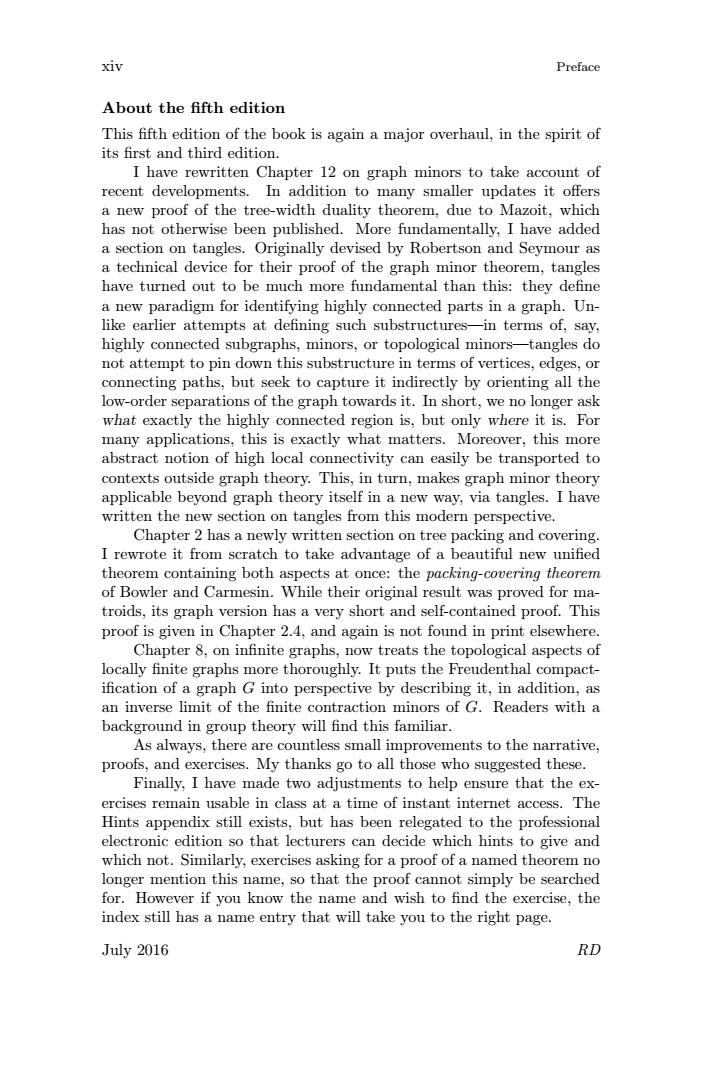正在加载图片...

xivPrefaceAboutthefiftheditionThis ffth edition of thee book is again a major overhaul, in the spirit ofits first and third edition.I have rewritten Chapter 12 on graph minors to take account ofrecent developments.In addition to many smaller updates it offersnew proof ofthetree-width duality theorem.duetoMazoit.whichhas not otherwise been published. More fundamentally.I have addeda sectionDntangles.OriginallydevisedbyRobertsonandSeymourasal device for their proof of the graphrti1,tangleshave turned out to beamental than this: they defirnoa new paradigm for identifying highly connected parts in a graph. Un-like earlier attempts at defining such substructuresin terms of, sayhighly connected subgraphs, minors, or topological minotanglesdonot attempt to pin down this substructure in terms of vertices, edges, orconnecting paths,but seek to captureit indirectly by orienting all thelow-order separations of the graph towards itIn short.we no longer askwhat exactly the highly connected region is.but only where it is.Fors, this is exactly what matters. Moreoover.thismabstonofhighlocalconnectivity can eorted toSVDecontexts outside graph theory. This, in turn, makes graph minoseorapplicable beyond graph theory itself in a new way, via tangles. I havewritten the new section on tangles from this modern perspective.Chapter 2hasanewlywritten section on tree packand coveringI rewrote it from scratch to take advantage of a beautiful new unifiedtheorem containbothaspectsatonce:thepacking-coveringtheoremof BowlerandCarmesin.Whiletheiroriginal result wasproved formtroids, its graph version hasavery shortand self-contained proof.Thisn in Chapter 2.4, and again is not fproof is givend in print elsewheChapter 8, on infinitegraphs, now treats the topological aspects oflocally finite graphs more thoroughly. It puts the Freudenthal compactification of a graph G into perspective by describing it, in addition, asinverse limit of the finite contractionnors of G.Readers withbackground in group theory will find this familiar.Asalways,thereare countless small improvementstothenarrativeand exercises. My thanksgo to all those who suggested thesDroofsFinally, I have made two adjustments to help ensure that the ex.sahleinataimeofinstaTheHints appendix still exists, but has been relegated to the professionalelectronic edition so that lecturers can decide which hints to give andwhich not. Similarly, exercises asking for a proof of a named theorem nolonger mention this name, so that the proof cannot simply be searchedfor. However if you know the name and wish to find the exercise, theindex still has a name entry that will take you to the right pageRDJuly 2016xiv Preface About the fifth edition This fifth edition of the book is again a major overhaul, in the spirit of its first and third edition. I have rewritten Chapter 12 on graph minors to take account of recent developments. In addition to many smaller updates it offers a new proof of the tree-width duality theorem, due to Mazoit, which has not otherwise been published. More fundamentally, I have added a section on tangles. Originally devised by Robertson and Seymour as a technical device for their proof of the graph minor theorem, tangles have turned out to be much more fundamental than this: they define a new paradigm for identifying highly connected parts in a graph. Unlike earlier attempts at defining such substructures—in terms of, say, highly connected subgraphs, minors, or topological minors—tangles do not attempt to pin down this substructure in terms of vertices, edges, or connecting paths, but seek to capture it indirectly by orienting all the low-order separations of the graph towards it. In short, we no longer ask what exactly the highly connected region is, but only where it is. For many applications, this is exactly what matters. Moreover, this more abstract notion of high local connectivity can easily be transported to contexts outside graph theory. This, in turn, makes graph minor theory applicable beyond graph theory itself in a new way, via tangles. I have written the new section on tangles from this modern perspective. Chapter 2 has a newly written section on tree packing and covering. I rewrote it from scratch to take advantage of a beautiful new unified theorem containing both aspects at once: the packing-covering theorem of Bowler and Carmesin. While their original result was proved for matroids, its graph version has a very short and self-contained proof. This proof is given in Chapter 2.4, and again is not found in print elsewhere. Chapter 8, on infinite graphs, now treats the topological aspects of locally finite graphs more thoroughly. It puts the Freudenthal compactification of a graph G into perspective by describing it, in addition, as an inverse limit of the finite contraction minors of G. Readers with a background in group theory will find this familiar. As always, there are countless small improvements to the narrative, proofs, and exercises. My thanks go to all those who suggested these. Finally, I have made two adjustments to help ensure that the exercises remain usable in class at a time of instant internet access. The Hints appendix still exists, but has been relegated to the professional electronic edition so that lecturers can decide which hints to give and which not. Similarly, exercises asking for a proof of a named theorem no longer mention this name, so that the proof cannot simply be searched for. However if you know the name and wish to find the exercise, the index still has a name entry that will take you to the right page. July 2016 RD